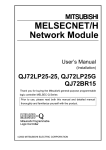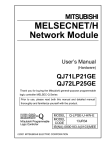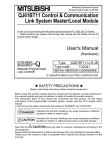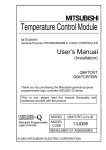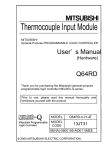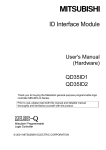Download MELSECNET/H Network Module User's Manual(Hardware)
Transcript
MELSECNET/H
Network Module
User’s Manual
(Hardware)
QJ71LP21-25, QJ71LP21G
QJ71BR11
Thank you for buying the Mitsubishi general-purpose programmable
logic controller MELSEC-Q Series
Prior to use, please read both this manual and detailed manual
thoroughly and familiarize yourself with the product.
2000 MITSUBISHI ELECTRIC CORPORATION
! SAFETY PRECAUTIONS !
(Always read these instructions before using this equipment.)
Before using this product, please read this manual and the relevant manuals
introduced in this manual carefully and pay full attention to safety to handle the
product correctly.
Precautionary notes in this manual cover only the installation of this product.
For precautions on designing and discarding this product, refer to "Safety
Precautions" in the MELSECNET/H Reference Manual.
For safety precautions on the PLC system, refer to the CPU User's Manual.
In this manual, the safety instructions are ranked as "DANGER" and
"CAUTION".
DANGER
Indicates that incorrect handling may cause hazardous
conditions, resulting in death or severe injury.
CAUTION
Indicates that incorrect handling may cause hazardous
conditions, resulting in medium or slight personal injury or
physical damage.
Note that the
CAUTION level may lead to a serious consequence
according to the circumstances.
Always follow the instructions of both levels because they are important to
personal safety.
Please save this manual to make it accessible when required and always
forward it to the end user.
A-1
[INSTALLATION PRECAUTIONS]
CAUTION
! Use the PLC in an environment that meets the general specifications
contained in CPU module user's manual.
Using this PLC in an environment outside the range of the general
specifications may cause electric shock, fire, malfunction, and damage to
or deterioration of the product.
! Insert the module's mounting latch into the base unit's mounting cutout
while pressing the module's loading lever, which is located at the bottom of
the module. Improper installation may result in a malfunction or breakdown,
or may cause the module to fall off.
To install the module in a place subject to strong vibration or impact,
secure it with mounting.
! Tighten the screw within the range of specified torque.
Loose screws may result in malfunctioning or cause the module to fall off.
If the screws are too tight, it may damage the screws, and as a result the
module may malfunction or fall off.
! Switch all phases of the external power supply off when mounting or
removing the module.
Not doing so may cause damage of the product.
! Do not directly touch the conductive area or electronic components of the
module.
Doing so may cause malfunction or failure in the module.
A-2
[WIRING PRECAUTIONS]
DANGER
! Switch all phases of the external power supply of the whole system off
when installing or placing wiring.
Not doing so may cause electric shock or damage to the product.
CAUTION
! Solder the coaxial cable's connector properly.
Improper soldering may cause the module to malfunction.
! Be careful not to let foreign matters such as sawdust or wire chips get
inside the module.
These may cause fires, failure or malfunction.
! The top surface of the module is covered with protective film to prevent
foreign objects such as cable offcuts from entering the module when
wiring.
Do not remove this film until the wiring is complete.
Before operating the system, be sure to remove the film to provide
adequate heat ventilation.
! Be sure to fix communication cables or power cables leading from the
module by placing them in the duct or clamping them.
Cables not placed in the duct or without clamping may hang or shift,
allowing them to be accidentally pulled, which may cause a module
malfunction and cable damage.
! When removing the communication cable or power cables from the
module, do not pull the cable. When removing the cable with a connector,
hold the connector on the side that is connected to the module.
When removing the cable connected to the terminal block, first loosen the
screws on the terminal block.
Pulling the cable that is still connected to the module may cause
malfunction or damage to the module or cable.
A-3
Revisions
*The manual number is given on the bottom left of the back cover.
Print Date
SEP., 2000
MAR., 2001
*Manual Number
IB(NA)-0800144-A
IB(NA)-0800144-B
Revision
First edition
Model addition
QJ71LP21G
This manual confers no industrial property rights or any rights of any other
kind, nor does it confer any patent licenses. Mitsubishi Electric Corporation
cannot be held responsible for any problems involving industrial property
rights which may occur as a result of using the contents noted in this manual.
2000 MITSUBISHI ELECTRIC CORPORATION
A-4
CONTENTS
1. Overview........................................................................................................ 1
2. Performance Specifications ........................................................................... 2
3. Handling ........................................................................................................ 4
3.1 Handling Precautions ............................................................................... 4
4. Part Identification Names............................................................................... 5
5. Wiring ............................................................................................................ 7
5.1 Precautions for Laying Optical Fiber Cables ............................................ 8
5.2 Precautions when Installing the Coaxial Cables ....................................... 9
5.3 Connecting the Connector for the Coaxial Cable.................................... 10
6. External Dimensions .................................................................................... 12
A-5
About the Manuals
The following manuals are also related to this product.
In necessary, order them by quoting the details in the tables below.
Related Manuals
Manual name
Q corresponding MELSECNET/H Network System
Reference Manual (PLC to PLC network)
Q corresponding MELSECNET/H Network System
Reference Manual (Remote I/O network)
Q/QnA/Q4AR
corresponding
MELSECNET/10
Network System Reference Manual
Manual No.
(Model code)
SH-080049
(13JF92)
SH-080124
(13JF96)
IB-66690
(13JF78)
Conformation to the EMC Directive and Low Voltage Instruction
For details on making Mitsubishi PLC conform to the EMC directive and low
voltage instruction when installing it in your product, please refer to Chapter
3,"EMC Directive and Low Voltage Instruction" of the PLC CPU User's
Manual(Hardware).
The CE logo is printed on the rating plate on the main body of the PLC that
conforms to the EMC directive and low voltage instruction
A-6
1. Overview
This manual explains how to handle the MELSECNET/H network module,
model numbers QJ71LP21-25 and QJ71BR11 (hereinafter referred to as the
network module).
After unpacking the network module, confirm that the following products are
enclosed.
Model number
Description
Quantity
Model QJ71LP21-25 MELSECNET/H network
1
QJ71LP21-25
module (optical link type)
Model QJ71LP21G MELSECNET/H network
QJ71LP21G
1
module (optical link type)
Model QJ71BR11 MELSECNET/H network module
1
(coaxial bus type)
QJ71BR11
F-type connector
1
Important
The coaxial bus-type network system requires terminal resistors at both
terminal stations of the network. The user should arrange for terminal resistors,
since the QJ71BR11 does not come with terminal resistors.
* Terminal resistor (75 Ω)
" A6RCON-R75
" BNC-TMP-05 (75)
(Manufactured by Hirose Electric Co., Ltd.)
1
2. Performance Specifications
The following table shows the performance specifications for the network
module:
Specifications
QJ71LP21-25
Item
Maximum number of link
points per network
Maximum
number of
link points
per station
PLC to PLC
network
Remote I/O
network
Communication speed
Communication method
Synchronous method
Transmission path format
Maximum number of
networks
Maximum number of
groups
PLC to PLC
Number of
network
connected
Remote I/O
stations
network
Overall distance
10Mbps
Distance
between
stations *2
25Mbps
Connection cable
Applicable connector
Number of I/O occupied
points
5 VDC current consumption
(A)
External dimensions (mm
(in.))
Weight (kg )
MELSECNET/H mode *1
(PLC to PLC network/
Remote I/O network)
LX/LY 8192 points
LB
19383 points
LW
19383 points
QJ71LP21G
MELSECNET/10 mode
*1
(PLC to PLC network)
8192 points
8192 points
8192 points
{(LB + LY) /2 + LW × 2) ≤ 2000 bytes
Remote master station to Remote I/O station
Remote I/O station to Remote Master station
{(LB + LY) /2 + LW × 2) ≤ 1600 bytes
10Mbps/25Mbps *4
(Switch changeing)
Token ring
Frame synchronous method
Duplex loop
10Mbps
239
32
64 stations (control station: 1, normal station: 63)
65 stations (Remote master station: 1, Remote I/O station: 64)
30 km (98430 ft.)
Sl optical cable: 500 m (1640.5 ft.)
SI type H-PCF optical cable :1 km (3281 ft.)
GI optical cable:
GI type H-PCF optical cable :1 km (3281 ft.)
2 km (36562 ft.)
QSl optical cable:1 km (3281 ft.)
Sl optical cable:200 m (656.2 ft.)
SI type H-PCF optical cable :400m (1312.4 ft.)
GI type H-PCF optical cable :1 km (3281 ft.)
QSl optical cable:1 km (3281 ft.)
Optical fiber cable (Arranged by user *3)
2-core optical connector plug (Arranged by user *3)
32 points (I/O assignment: intelligent 32 points)
0.55
98 (3.86) (H) × 27.4 (1.08) (W) × 90 (3.54) (D)
0.11
2
*1: Mode selection is performed using network parameters.
*2: There are restrictions to the distance between stations, being determined according to
the type of cable and number of stations. See sections 5.1 .
*3: Specialised training and specific tools are required to connect the connector to the
optical-fiber cable; the connector itself is a custom product. Please contact your nearest
Mitsubishi Electric System Service Corporation when purchasing these items.
*4: Only 25Mbps is MELSECNET/H mode.
Specifications
QJ71BR11
LX/LY NET/10H mode: 8192 points, NET/10 mode: 8192 *1
PLC to PLC
LB
NET/10H mode: 16383 points, NET/10 mode: 8192 *1
Maximum
network
LW
NET/10H mode: 16383 points, NET/10 mode: 8192 *1
number of link
points per
LX/LY 8192 points
Remote I/O
network
LB
16383 points
network
LW
16383 points
PLC to PLC
{(LB + LY) /2 + LW × 2) ≤ 2000 bytes
Maximum
network
number of link
Remote master station to Remote I/O station
points per
Remote I/O
Remote I/O station to Remote Master station
station
network
{(LB + LY) /2 + LW × 2) ≤ 2000 bytes
Communication speed
10 Mbps
Communication method
Token bus
Synchronous method
Frame synchronous method
Transmission path format
Single bus
Maximum number of
239
networks
Maximum number of groups 32
Number of connected stations 32 stations (control station: 1, normal station: 31)
500 m (1640.5 ft.) (5C-2V)
300 m (984.3 ft.) (3C-2V)
Overall distance
Can be extended to a maximum of 2.5 km (8202.5 ft.) using
maximum 4 repeater modules (A6BR10, A6BR10-DC).
500 m (1640.5 ft.) (5C-2V)
Distance between stations *2
300 m (984.3 ft.) (3C-2V)
Coaxial cable
Connection cable
Equivalent to 3C-2V, 5C-2V (Arranged by user)
BNC-P-3-Ni-CAU (For 3C-2V), BNC-P-5-Ni-CAU (For 5C-2V)
Applicable connector
Equivalent to (DDK)
Number of I/O occupied
32 points (I/O assignment: intelligent 32 points)
points
5VDC current consumption
0.75
(A)
External dimensions
98 (3.86) (H) × 27.4 (1.08) (W) × 90 (3.54) (D)
(mm (in.))
Weight (kg )
0.11
*1: Mode selection is performed using network parameters.
*2: There are restrictions to the distance between stations, being determined according to
the type of cable and number of stations. See sections 5.2.
Item
For general specifications of the network module, refer to the user's manual for the CPU that
is to be used.
3
3. Handling
CAUTION
! Use the PLC in an environment that meets the general specifications
contained in CPU module user's manual.
Using this PLC in an environment outside the range of the general
specifications may cause electric shock, fire, malfunction, and damage to
or deterioration of the product.
! Insert the module's mounting latch into the base unit's mounting cutout
while pressing the module's loading lever, which is located at the bottom of
the module. Improper installation may result in a malfunction or breakdown,
or may cause the module to fall off. To install the module in a place subject
to strong vibration or impact, secure it with mounting screws using the
specified clamping torque. Loose screws may result in malfunctioning or
cause the module to fall off. If the screws are too tight, it may damage the
screws, and as a result the module may malfunction or fall off.
! Switch all phases of the external power supply off when mounting or
removing the module.
Not doing so may cause damage of the product.
! Do not directly touch the conductive area or electronic components of the
module.
Doing so may cause malfunction or failure in the module.
3.1 Handling Precautions
(1) Since the module case is made of resin, do not drop it or subject it to
strong impact.
(2) The module can easily be secured to the base unit using the hooks
located at the top of the module. However, if the module is to be placed in
an area that is subject to strong vibration or impact, we recommend that it
be secured with module mounting screws (provided by the user). In that
case, tighten the module mounting screws within the following range.
Module mounting screws (M3 × 12): The range of clamping torque is 36 to
48 N·cm .
4
4. Part Identification Names
(a) QJ71LP21-25, QJ71LP21G
(b) QJ71BR11
QJ71LP21-25
90 1
90 1
23
23
X1
78
78
0
EF 12
BCD
01
EF 2
89
67 A
345
3)
3)
BCD
OUT
4)
4)
QJ71LP21-25
Number
1)
2)
2)
4)
IN
MODE
89
67 A
345
MODE
1)
4 56
90 1
X10
MNG
D.LINK
RD
L ERR.
45 6
2)
4 56
23
X1
STATION NO.
23
4 56
X10
RUN
T.PASS.
SD
ERR.
90 1
STATION NO.
QJ71BR11
1)
78
MNG
D.LINK
RD
L ERR.
78
RUN
T.PASS.
SD
ERR.
QJ71BR11
Name
Display LED
Station number setting switches
Number
3)
4)
Name
Mode setting switch
Connector
(1) Display contents for LEDs
LED name
RUN
QJ71LP21-25
RUN
T.PASS
SD
ERR.
MNG
D.LINK
T. PASS
RD
L ERR.
SD
ERR.
MNG
D. LINK
RD
L. ERR.
Display contents
On: Operating normally
Off: WDT error occurred
On: Executing baton pass
Flicker: Executing test
Off: Baton pass not yet executed (host is
disconnecting)
On: Data being transmitted
Off: Data not yet transmitting
On: Setting error occurred
Flicker: Error detected by a test
Off: No setting error
On: Operating as a control station or sub control
station
Off: Operating as a normal station
On: Data link being executed
Off: Data link not yet executed
On: Data being received
Off: Data not yet received
On: Communication error occurred
Off: No communication error
5
(2) Setting contents for each switch
(a) Station number setting switches
STATION NO.
10s unit
X10
1s unit
X1
Switch
name
Setting
content
Type
Setting range
Station Sets the PLC to
number station PLC
setting
number network
switches
QJ71LP21-25,
QJ71LP21G: 1 to 64
QJ71BR11: 1 to 32
Setting error for other
than the above
Remote All module
I/O
0: Remote master station
network Setting error for other
than the above
Setting at
time of
shipment
1
(b) Mode setting switch
1) QJ71LP21G, QJ71BR11
Switch
name
MODE
Setting
content
Type
Mode Sets the PLC to
setting operating PLC
switch mode
network
"
Remote
I/O
network
Setting range
0: On-line
1: Self-loopback test
2: Internal self-loopback
test
3: Hardware test
4 to F: Use prohibited
Setting at
time of
shipment
0
2) QJ71LP21-25
Setting at
Type
Setting range
time of
shipment
Mode Sets the PLC to 0: On-line
10Mbps
0
setting operating PLC
1: Self-loopback used
switch mode
network
test
"
*1
2: Internal selfRemote
loopback test
I/O
3: Hardware test
network 4: On-line
25Mbps
5: Self-loopback used
test
6: Internal selfloopback test
7: Hardware test
8 to F: Use prohibited
Switch
name
Setting
content
*1:Contorl station, normal station of PLC to PLC network or remote I/O network when making
to online with Mode setting switch remote master station and remote I/O station is made
the switch the same set.
6
5. External Wiring
DANGER
! Switch all phases of the external power supply of the whole system off
when installing or placing wiring.
Not doing so may cause electric shock or damage to the product.
CAUTION
! Solder the coaxial cable's connector properly.
Improper soldering may cause the module to malfunction.
! Be careful not to let foreign matters such as sawdust or wire chips get
inside the module.
These may cause fires, failure or malfunction.
! The top surface of the module is covered with protective film to prevent
foreign objects such as cable offcuts from entering the module when
wiring.
Do not remove this film until the wiring is complete.
Before operating the system, be sure to remove the film to provide
adequate heat ventilation.
! Be sure to fix communication cables or power cables leading from the
module by placing them in the duct or clamping them.
Cables not placed in the duct or without clamping may hang or shift,
allowing them to be accidentally pulled, which may cause a module
malfunction and cable damage.
! When removing the communication cable or power cables from the
module, do not pull the cable. When removing the cable with a connector,
hold the connector on the side that is connected to the module.
When removing the cable connected to the terminal block, first loosen the
screws on the terminal block.
Pulling the cable that is still connected to the module may cause
malfunction or damage to the module or cable.
7
5.1 Precautions for Laying Optical Fiber Cables
(1) The distance between stations varies depending on the type of optical
fiber cable used.
(a) QJ71LP21-25
Distance between stations (m)
10Mbps used
25Mbps used
500 (1640.5 ft.)
200 (656.2 ft.)
300 (984.3 ft.)
100(328.1 ft.)
500 (1640.5 ft.)
200 (656.2 ft.)
1000 (3281 ft.)
400 (1312.4 ft.)
1000 (3281 ft.)
1000 (3281 ft.)
1000 (3281 ft.)
1000 (3281 ft.)
Type
L type
SI optical fiber cable
(Old type: A-2P-#)
H type
SI optical fiber cable
SI type H-PCF optical fiber cable
GI type H-PCF optical fiber cable
QSI optical fiber cable
(b) QJ71LP21G
Type
Distance between stations (m)
GI optical fiber cable
2000 (6562 ft.)
(2) When connecting an optical fiber cable, the following restrictions on the
bending radius must be observed. Please confirm bending radius of the
cable with the cable used.
(3) Please maintain the optical fiber cable permissible bending radius with a
checking tool.
Enquiries for the checking tool for optical fiber cable bending radius
maintenance are handled by Mitsubishi Electric System Service
Corporation. Please contact your nearest Mitsubishi Electric System
Service Corporation for detail.
(4) When laying the optical-fiber cable, do not touch the fiber core of the
cable connector or module connector, or let dirt or dust collect on it.
If oil from the hands, dirt or dust should adhere to the core, the
transmission loss will increase, causing a malfunction in the data link.
(5) When attaching or detaching the optical-fiber cable to/from the module,
hold the cable connector securely with the hands.
(6) Connect the cable connector and module connector securely until you
hear a "click" sound.
8
5.2 Precautions when Installing the Coaxial Cables
(1) Between stations, use the cable length indicated in the table below
according to the number of stations connected.
There is the possibility of communication errors if the cable length other
than the table listed below is used.
Number of
stations
connected
2 to 9 stations
10 to 33 stations
Cable length between stations
Total extension
distance
1 to 300 m (3C-2V) (3.28 to 984.3 ft.)
1 to 500 m (5C-2V) (3.28 to 1640.5 ft.)
1 to 5 m (3C-2V, 5C-2V) (3.28 to 16.41 ft.)
13 to 17 m (3C-2V, 5C-2V) (42.65 to 55.78 ft.)
25 to 300 m (3C-2V) (82.03 to 984.3 ft.)
25 to 500 m (5C-2V) (82.03 to 164.5 ft.)
300 m (984.3 ft.)
(3C-2V)
500 m (1640.5 ft.)
(5C-2V)
(2) If there is the possibility of an increase in the number of stations due to
system expansion, install the cables with advance consideration of the
restrictions.
(3) When using a repeater module (models A6BR10 or A6BR10-DC), use the
station-to-station cable length indicated by "10 to 33" stations, regardless
of the number of stations connected or the number of repeater modules.
(4) Install the coaxial cables at least 100 mm (3.94 ft.) away from other power
cables and control cables.
(5) Consider wiring using double-shielded coaxial cable in places that are
subject to large amounts of noise.
Double shielded coaxial cable
Mitsubishi Cable ... 5C-2V-CCY
Grounding
(6) When connecting a coaxial cable, the following restrictions on the
bending radius must be observed.
Cable type
3C-2V
5C-2V
Allowable bending radius
r [mm (in.)]
23 (0.91)
30 (1.18)
Connector
A [mm (in.)]
A
55 (2.17)
r
Module front
9
(7) Do not pull any of the connected coaxial cables.
This will cause a faulty contact, cable disconnection, or damage to the
module.
(8) Make sure to connect a terminal resistor to both terminal stations of the
coaxial bus type network system.
(9) Depending on the usage environment, some white oxidation deposits may
be seen on the F type connector. However, oxidation will not occur on the
connection area, so there will be no problems with the function of the unit.
5.3 Connecting the Connector for the Coaxial Cable
The following section explains how to connect the BNC connector (connector
plug for the coaxial cable) to the cable.
(1) Structure of the BNC connector and coaxial cable
The structure of the BNC connector and coaxial cable are shown in the
figure below.
Parts comprising the BNC connector
Nut
Structure of the coaxial cable
Gasket
Washer
External conductor
Outer sheath
Insulation material
Plug shell
Clamp
Contact
Internal conductor
(2) How to connect the BNC connector and the coaxial cable
(a) Cut off the outer sheath of the coaxial cable to the length shown in the
diagram below.
15mm
(0.59 in.)
Cut this portion of the outer sheath
(b) Feed the nut, washer, gasket and clamp on the coaxial cable through,
as shown below, then unfasten the external conductor.
Clamp
Nut
Washer
Gasket
10
(c) Cut the external conductor, insulation material and internal conductor
to the dimensions shown below. However, cut the external conductor
to the same dimension as the tapered section of the clamp and smooth
it down to the clamp.
Insulation
Internal
material
conductor
3mm
(0.12in.)
6mm
(0.24in.)
Clamp and
external conductor
(d) Solder the contact to the internal conductor.
Solder here
(e) Insert the connector assembly in (d) into the plug shell and screw the
nut into the plug shell.
Important
Note the following precautions when soldering the internal conductor and
contact.
" Make sure that the solder does not bead up at the soldered section.
" Make sure there are no gaps between the connector and cable insulator
or they do not cut into each other.
" Perform soldering quickly so the insulation material does not become
deformed.
11
6. External Dimensions Diagram
(1) QJ71LP21-25, QJ71LP21G
QJ71LP21-25
MNG
D.LINK
RD
L ERR.
23
456
X10
90 1
STATION NO.
78
RUN
T.PASS.
SD
ERR.
90 1
456
23
98(3.86)
78
X1
IN
89 A
01
EF 2
67
3 45
BCD
MODE
OUT
QJ71LP21-25
90.5(3.56)
*1
27.4(1.08)
*1:Please contact your nearest Mitsubishi Electric System Service Corporation for detail.
Unit: mm (in.)
(2) QJ71BR11
QJ71BR11
RUN
MNG
T.PASS.
SD
ERR.
D.LINK
RD
L ERR.
901
23
456
X10
78
STATION NO.
90 1
456
23
78
X1
98(3.86)
01
EF 2
89
67 A
345
BCD
MODE
QJ71BR11
90.5(3.56)
55(2.17)
27.4(1.08)
Unit: mm (in.)
12
Warranty
Mitsubishi will not be held liable for damage caused by factors found not to be the cause of
Mitsubishi; machine damage or lost profits caused by faults in the Mitsubishi products;
damage, secondary damage, accident compensation caused by special factors
unpredictable by Mitsubishi; damages to products other than Mitsubishi products; and to
other duties.
For safe use
" This product has been manufactured as a general-purpose part for general industries, and
has not been designed or manufactured to be incorporated in a device or system used in
purposes related to human life.
" Before using the product for special purposes such as nuclear power, electric power,
aerospace, medicine or passenger movement vehicles, consult with Mitsubishi.
" This product has been manufactured under strict quality control. However, when installing
the product where major accidents or losses could occur if the product fails, install
appropriate backup or failsafe functions in the system.
Country/Region Sales office/Tel
U.S.A
Mitsubishi Electric Automation Inc.
500 Corporate Woods Parkway Vernon
Hills, IL 60061
Tel : 1-847-478-2100
Brazil
MELCO-TEC Rep. Com.e Assessoria
Tecnica Ltda.
Av. Rio Branco, 123-15 ,and S/1507,
Rio de Janeiro, RJ CEP 20040-005,
Brazil
Tel : 55-21-221-8343
Germany
Mitsubishi Electric Europe B.V. German
Branch
Gothaer Strasse 8 D-40880 Ratingen,
GERMANY
Tel : 49-2102-486-0
U.K
Mitsubishi Electric Europe B.V. UK
Branch
Travellers Lane, Hatfield, Herts., AL10
8XB,UK
Tel : 44-1707-276100
Italy
Mitsubishi Electric Europe B.V. Italian
Branch
Centro Dir. Colleoni, Pal. Perseo - Ingr.2
Via Paracelso 12, 20041 Agrate B.,
Milano, Italy
Tel:39-039-6053301
Spain
Mitsubishi Electric Europe B.V. Spanish
Branch
Pol. Ind. "Can Magi"- C/.Joan Buscalla,
2-4-A.C.420
08190 Sant Cugat del Valles, Barcelona,
Spain
Tel:34-935-653135
South Africa
MSA Manufacturing (Pty) Ltd.
P O Box 39733 Bramley 201 8
Johannesburg, South Africa
Tel : 27-11-444-8080
Hong Kong
Ryoden International Ltd.
10th Floor, Manulife Tower, 169 Electric
Road, North Point, HongKong
Tel : 852-2887-8870
Country/Region Sales office/Tel
China
Ryoden International Shanghai Ltd.
3F Block5 Building Automation
Instrumentation Plaza 103 Cao Bao Rd.
Shanghai 200233 China
Tel : 86-21-6475-3228
Taiwan
Setsuyo Enterprise Co., Ltd.
6F., No.105 Wu-Kung 3rd.RD, Wu-Ku
Hsiang, Taipei Hsine, Taiwan R.O.C.
Tel : 886-2-2299-2499
Korea
STC Techno Seoul Co., Ltd.
1F Dong Seo Game Channel Bldg.,
660-11, Deungchon-dong Kangsec-ku,
Seoul, Korea
Tel : 82-2-3668-6567
Singapore
Mitsubishi Electric Asia Pte, Ltd.
307 ALEXANDRA ROAD #05-01/02,
MITSUBISHI ELECTRIC BUILDING
SINGAPORE 159943
Tel : 65-473-2480
Thailand
F. A. Tech Co.,Ltd.
1138/33-34 Rama 3 Road, Yannawa,
Bangkok 10120, Thailand
Tel : 66-2-295-2861
Indonesia
P.T. Autoteknindo SUMBER MAKMUR
Kompleks Agung Sedayu Propertindo
(Harco Mangga Dua)
Blok H No.4 JI Mangga Dua Raya
Jakarta Pusat 10730-Indonesia.
Tel : 62-21-336292
India
Messung Systems Put,Ltd.
Electronic Sadan NO:111 Unit No15,
M.I.D.C BHOSARI,PUNE-411026
Tel : 91-20-7128927
Australia
Mitsubishi Electric Australia Pty. Ltd.
348 Victoria Road, PostalBag, No 2,
Rydalmere, N.S.W 2116, Australia
Tel : 61-2-9684-7777
HEAD OFFICE:MITSUBISHI DENKI BLDG MARUNOUCHI TOKYO 100-8310 TELEX:J24532 CABLE MELCO TOKYO
NAGOYA WORKS:1-14, YADA-MINAMI 5, HIGASHI-KU, NAGOYA, JAPAN
When exported from Japan, this manual does not require application to the Ministry
of International Trade and Industry for service transaction permission.
Specifications subject to change without notice.
Printed in Japan on recycled paper.





















